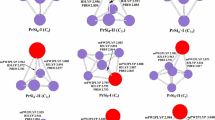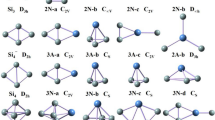Abstract
The equilibrium geometries, electronic structures and electronic properties of PmSi n (n = 3–10) clusters were systematically investigated using the ABCluster global search technique combined with density functional methods. The results revealed that the most stable structure of neutral PmSi n and their anions can be viewed as replacing a Si atom of the ground state structure of Si n+1 with a Pm atom. The adiabatic electron affinities of PmSi n are evaluated, and they differ little from those of SmSi n and EuSi n . Analyses of HOMO–LUMO gaps showed that introducing Pm atom to Si cluster can significantly improve photochemical reactivity of the cluster. And the improved effects are as good as those of the introducing Sm and Eu atom to Si cluster. The NPA calculations indicated that the 4f electrons of Pm atom in PmSi n (n = 3–10) clusters hardly participate in bonding and provide the total magnetic moments. Dissociation energy (DE) of rare earth metal (REM) atom from the lowest energy structure of REMSi n (n = 3–10) and their anions was calculated. The DEs of PmSi n , SmSi n and EuSi n are nearly identical. The DEs of PmSi − n , SmSi − n and EuSi − n are also nearly equal, and they are smaller than those of HoSi − n and PrSi − n .






Similar content being viewed by others
References
Ohara M, Miyajima K, Pramann A, Nakajima A, Kaya K (2002) Geometric and electronic structures of terbium–silicon mixed clusters (TbSi n , 6 ≤ n≤16). J Phys Chem A 106:3702–3705
Koyasu K, Atobe J, Furuse S, Nakajima A (2008) Anion photoelectron spectroscopy of transition metal and lanthanide metal-silicon clusters: MSi − n (n = 6-20). J Chem Phys 129:214301
Grubisic A, Wang HP, Ko YJ, Bowen KH (2008) Photoelectron spectroscopy of europium-silicon clusters anions, EuSi − n (3 ≤ n≤17). J Chem Phys 129:054302
Grubisic A, Ko YJ, Wang HP, Bowen KH (2009) Photoelectron spectroscopy of Lanthanide-silicon cluster anions LnSi − n (3 ≤ n≤13, Ln = Ho, Gd, Pr, Sm, Eu, Yb): prospect for magnetic silicon-based clusters. J Am Chem Soc 131:10783–10790
Han JG, Hagelberg F (2009) Recent progress in the computational study of silicon and germanium clusters with transition metal impurities. J Comput Theor Nanosci 6(2):257–269
Zhao RN, Yuan Y, Han JG, Duan Y (2014) Actinide elements and germanium: a first-principles density functional theory investigation of the electronic and magnetic properties of ApGe (Ap = Ac−Lr) diaotms. RSC Adv 4:59331–59337
Hang TD, Hung HM, Nguyen MT (2016) Structural assignment, and electronic and magnetic properties of lanthanide metal doped silicon heptamers Si7M0/−with M = Pr, Gd and Ho†. Phys Chem Chem Phys 18:31054
Li XJ, Yan ZJ, Li SN (2016) The nature of structure and bonding between transition metal and mixed Si–Ge Tetramers: a 20-electron superatom system. J Comput Chem 37:2316–2323
Pak C, Rienstra-Kiracofe JC, Schaefer HF (2000) Electron affinities of silicon hydrides: SiHn (n = 0–4) and Si2Hn (n = 0–6). J Phys Chem A 104:11232–11242
Li XJ, Claes P, Haertelt M, Lievens P, Janssens E, Fielicke A (2016) Structural determination of niobium-doped silicon clusters by far-infrared spectroscopy and theory. Phys Chem Chem Phys 18:6291
Zhao RN, Han JG (2014) Geometrical stabilities and electronic properties of Si n (n = 12–20) clusters with rare earth holmium impurity: a density functional investigation. RSC Adv 4:64410–64418
Beck SM (1987) Studies of silicon cluster-metal atom compound formation in a supersonic molecular beam. J Chem Phys 87(7):4233–4234
Koyasu K, Akutsu M, Mitsui M, Nakajima A (2005) Selective Formation of MSi16 (M = Sc, Ti, and V). J Am Chem Soc 127:4998–4999
Huang XM, Xu HG, Lu SJ, Su Y, King RB, Zhao JJ, Zheng WJ (2004) Discovery of a silicon-based ferromagnetic wheel structure in VxSi12 −(x = 1–3) clusters: photoelectron spectroscopy and density functional theory investigation†. Nanoscale 6:14617–14621
Li XJ, Han Q, Yang XH, Song RJ, Song LM (2016) Modification of alkali metals on silicon-based nanoclusters: an enhanced nonlinear optical response 659:93–99
Hou LY, Yang JC, Liu Yuming (2016) Reexamination of structures, stabilities, and electronic properties of holmium-doped silicon clusters HoSin (n = 12–20). J Mol Model 22:193
Qi P, Jiang S (2008) Growth behavior of La@Si n (n = 1–21) metal-encapsulated clusters. J Chem Phys 128:084711
Cao TT, Feng XJ, Zhao LX, Liang X, Lei YM, Luo YH (2008) Structure and magnetic properties of La-doped Si n (n = 1–12,24) clusters: a density functional theory investigation. Eur Phys J D 49:343–351
Feng YT, Yang JC (2017) Stability and electronic properties of praseodymium-doped silicon clusters PrSin (n = 12–21). J Mol Model 23:180
Li CG, Pan LJ, Shao P, Ding LP, Feng HT, Luo DB, Liu B (2015) Structures, stabilities, and electronic properties of the neutral and anionic SinSmλ (n = 1–9, λ = 0, − 1) clusters: comparison with pure silicon clusters. Theor Chem Acc 134:34
Zhao GF, Sun JM, Gu YZ, Wang YX (2009) Density-functional study of structural, electronic, and magnetic properties of the EuSi n (n = 1–13) clusters. J Chem Phys 131:114312
Wang J, Liu Y, Li YC (2010) Magnetic silicon fullerene. Phys Chem Chem Phys 12:11428–11431
Liu TG, Zhao GF, Wang YX (2011) Structural, electronic and magnetic properties of GdSi n (n = 1–17) clusters: a density functional study. Phys Lett A 375:1120–1127
Liu TG, Zhang WQ, Li YL (2014) First-principles study on the structure, electronic and magnetic properties of HoSi n (n = 1–12, 20) clusters. Front Phys 9:210–218
Zhao RN, Ren ZY, Guo P, Bai JT, Zhang CH, Han JG (2006) Geometries and electronic properties of the neutral and charged rare earth Yb-doped Si n (n = 1–6) clusters: a relativistic density functional investigation. J Phys Chem A 110:4071–4079
Zhao RN, Han JG, Bai JT, Liu FY, Sheng LS (2010) The medium-sized charged YbSi ± n (n = 7–13) clusters: a relativistic computational investigation. Chem Phys 378:82–87
Zhao RN, Han JG, Bai JT, Liu FY, Sheng LS (2010) A relativistic density functional study of Si n (n = 7–13) clusters with rare earth ytterbium impurity. Chem Phys 372:89–95
Cao TT, Zhao LX, Feng XJ, Lei YM, Luo YH (2009) Structural and electronic properties of LuSi n (n = 1–12) clusters: a density functional theory investigation. J Mol Struct THEOCHEM 895:148–155
Feng YT, Yang JC, Liu YM (2016) Study on the structures and properties of praseodymium-doped silicon clusters PrSin (n = 3–9) and their anions with density functional schemes. Theor Chem Acc 135:258
Xie XH, Hao DS, Liu YM, Yang JC (2015) Samarium doped silicon clusters SmSi n (n = 3–10) and their anions: structures, thermochemistry, electron affinities, and magnetic moments. Comput Theor Chem 1074:1–8
Yang JC, Wang J, Hao YR (2015) Europium-doped silicon clusters EuSi n (n = 3–11) and their anions: structures, thermochemistry, electron affinities, and magnetic moments. Theor Chem Acc 134:81
Yang JC, Feng YT, Xie XH, Wu HW, Liu YM (2016) Gadolinium-doped silicon clusters GdSin (n = 2–9) and their anions: structures, thermochemistry, electron affinities, and magnetic moments. Theor Chem Acc 135:204
Hou LY, Yang JC, Liu YM (2017) Density-functional study of the structures and properties of holmium-doped silicon clusters HoSin (n = 3–9) and their anions. J Mol Model 23:117
Xie XH, Hao DS, Yang JC (2015) Ytterbium doped silicon clusters YbSi n (n = 4-10) and their anions: structures, thermochemistry, and electron affinities. Chem Phys 461:11–19
He S, Yang JC (2017) Study on structure and property of lutetium introduced silicon clusters LuSin (n = 3–10) and their anions with density functional theory. J Clust Sci. doi:10.1007/s10876-017-1225-x
Schwabe T, Grimme S (2006) Towards chemical accuracy for the thermodynamics of large molecules: new hybrid density functionals including non-local correlation effects. Phys Chem Chem Phys 8:4398–4401
Zhang J, Dolg M (2015) ABCluster: the artificial bee colony algorithm for cluster global optimization. Phys Chem Chem Phys 17:24173–24181
Frisch MJ, Trucks GW, Schlegel HB, Scuseria GE, Robb MA, Cheeseman JR, Scalmani G, Barone V, Mennucci B, Petersson GA, Nakatsuji H, Caricato M, Li X, Hratchian HP, Izmaylov AF, Bloino J, Zheng G, Sonnenberg JL, Hada M, Ehara M, Toyota K, Fukuda R, Hasegawa J, Ishida M, Nakajima T, Honda Y, Kitao O, Nakai H, Vreven T, JA Montgomery Jr, Peralta JE, Ogliaro F, Bearpark M, Heyd JJ, Brothers E, Kudin KN, Staroverov VN, Keith T, Kobayashi R, Normand J, Raghavachari K, Rendell A, Burant JC, Iyengar SS, Tomasi J, Cossi M, Rega N, Millam JM, Klene M, Knox JE, Cross JB, Bakken V, Adamo C, Jaramillo J, Gomperts R, Stratmann RE, Yazyev O, Austin AJ, Cammi R, Pomelli C, Ochterski JW, Martin RL, Morokuma K, Zakrzewski VG, Voth GA, Salvador P, Dannenberg JJ, Dapprich S, Daniels AD, Farkas Ö, Foresman JB, Ortiz JV, Cioslowski J, Fox DJ (2010) Gaussian 09 revision C.01. Gaussian Inc, Wallingford
Staroverov VN, Scuseria GE, Tao J (2003) Comparative assessment of a new nonempirical density functional: molecules and hydrogen-bonded complexes. J Chem Phys 119:12129–12137
Dolg M, Stoll H, Savin A, Preuss H (1989) Energy-adjusted pseudopotentials for the rare earth elements. Theor Chim Acta 75:173–194
Feller D (1996) The role of databases in support of computational chemistry calculations. J Comput Chem 17:1571–1586
Schuchardt KL, Didier BT, Elsethagen T (2007) Basis set exchange: a community database for computational sciences. J Chem Inf Model 47(3):1045–1052
Woon DE, Dunning TH (1993) Gaussian basis sets for use in correlated molecular calculations. II. The atoms aluminum through argon. J Chem Phys 98:1358–1371
Buchachenko AA, Chalasiński G, Szeześniak MM (2007) Diffuse basis functions for small-core relativistic pseudopotential basis sets and static dipole polarizabilities of selected lanthanides La, Sm, Eu, Tm and Yb. Struct Chem 18:769–772
Cao X, Dolg M (2002) Segmented contraction scheme for small-core lanthanide pseudopotential basis sets. J Mol Struct THEOCHEM 581:139–147
Raghavachari K (1986) Theoretical study of small silicon clusters: equilibrium geometries and electronic structures of Sin (n = 2–7,10). J Chem Phys 184:5672–5686
Yang JC, Xu WG, Xiao WS (2005) The small silicon clusters Sin, (n = 2–10) and their anions: structures, themochemistry, and electron affinities. J Mol Struct (THEOCHEM) 719:89–102
Zhu X, Zeng XC (2003) Structures and stabilities of small silicon clusters: Ab initio molecular-orbital calculations of Si7–Si11. J Chem Phys 118:3558–3570
Acknowledgements
This study was supported by the National Natural Science Foundation of China (Grant No. 21263010), by Program for Innovative Research Team in Universities of Inner Mongolia Autonomous Region (Gran No. NMGIRT-A1603), by the Inner Mongolia Natural Science Foundation (Grant No. 2015MS0216), and by the Inner Mongolia institutions of higher learning scientific research projects (Grant No. NJZY16419).
Author information
Authors and Affiliations
Corresponding author
Rights and permissions
About this article
Cite this article
He, S., Yang, J. Promethium-doped silicon clusters PmSi n (n = 3–10) and their anions: structures, thermochemistry, electron affinities and magnetic moments. Theor Chem Acc 136, 93 (2017). https://doi.org/10.1007/s00214-017-2126-7
Received:
Accepted:
Published:
DOI: https://doi.org/10.1007/s00214-017-2126-7




